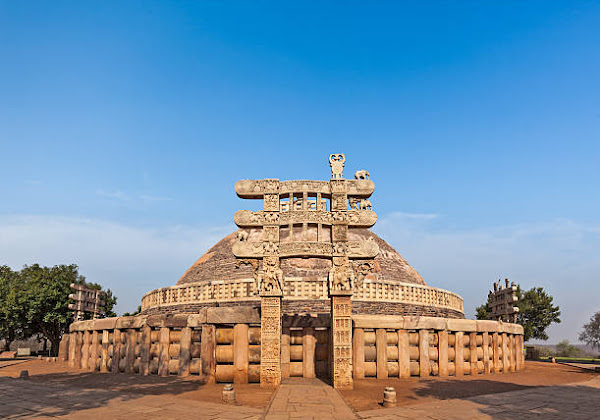Sanchi Stupa 1, Madhya Pradesh

Address
Sanchi Stupa 1, Sanchi, Madhya Pradesh-464661
Diety
Buddha
Introduction
Sanchi is a Buddhist complex, famous for its Great Stupa, on a hilltop at Sanchi Town in Raisen District of the State of Madhya Pradesh, India. It is located in 46 kilometres (29 mi) north-east of Bhopal, capital of Madhya Pradesh. Sanchi is the center of a region with a number of stupas, all within a few miles of Sanchi, including Satdhara (9 km to the W of Sanchi, 40 stupas). The Great Stupa at Sanchi is one of the oldest stone structures in India, and an important monument of Indian Architecture. It was originally commissioned by the Mauryan emperor Ashoka the Great in the 3rd century BCE. Its nucleus was a simple hemispherical brick structure built over the relics of the Buddha. It was crowned by the ‘chhatra’, a parasol-like structure symbolising high rank, which was intended to honour and shelter the relics. The original construction work of this stupa was overseen by Ashoka.
Puranic Significance
The monuments at Sanchi today comprise a series of Buddhist monuments starting from the Mauryan Empire period (3rd century BCE), continuing with the Gupta Empire period (5th century CE), and ending around the 12th century CE. It is probably the best preserved group of Buddhist monuments in India. The oldest, and also the largest monument, is the Great Stupa also called Stupa No. 1, initially built under the Mauryans, and adorned with one of the Pillars of Ashoka. During the following centuries, especially under the Shungas and the Satavahanas, the Great Stupa was enlarged and decorated with gates and railings, and smaller stupas were also built in the vicinity, especially Stupa No.2, and Stupa No.3 Sanchi Stupa was commissioned by King Ashoka in the 2nd century BCE. Its center is a huge hemispherical brick dome with an elevated terrace and a balustrade built over the relics of Lord Buddha. It is crowned by the chhatri, an umbrella like structure which symbolises high rank and also was intended to honour and shelter the relics. In the 1st century BCE during the reign of the Satavahanas, four intricately carved gateways and a banister encircling the entire structure of Stupa were added. The Sanchi Stupa built during the Mauryan period was made of bricks. The complex flourished until the 11th century. The construction of the stupa was commissioned in several locations across India in order to spread Buddhism. During the rule of the Shunga Emperor, the stupa was further expanded with stone slabs to practically double its original size. The dome was flattened and covered by stone slabs. Three superimposed chatras were built to crown the dome. It symbolised the Wheel of Law or ‘dharma’. A high rounded drum that can be reached through a double staircase became the seat of the dome enabling one to circumambulate the sacred dome. The gateways and balustrades come alive with inscriptions and illustrations narrating the life of Lord Buddha and tales from Aryasura’s Jatakamala. The spectrum of carvings are a symbolic manifestation of the Buddha that have been used in the form of trees and inanimate objects like thrones, wheels or footprints. The Sanchi Stupa is also the site of the Ashoka Pillar. The polished sandstone pillar stands at the main gateway and is reminiscent of the Greco-Buddhist Architecture. Presently, only bottom half of the erection stands at the site. The upper half is displayed at the Sanchi Archaeological Museum which is close by.
Special Features
This large hemispherical dome, more than 50 ft high with a diameter of more than 30m was constructed to honour Lord Buddha and houses many important Buddhist relics. It is meant to serve as a sacred burial mound for the distributed remains of Lord Buddha. Sanchi is known for its ancient Stupas, monasteries, the Ashoka Pillar, Toranas or ornate gateways with intricate carvings and other remnants of the rich Buddhist culture which date back to the 3rd century B. C. It is one of the most important places for Buddhist pilgrimage and pilgrims from around the world.
Century/Period/Age
3rd century BCE.
Managed By
Archaeological Survey of India (ASI)
Nearest Bus Station
Bhopal
Nearest Railway Station
Bhopal
Nearest Airport
Bhopal









